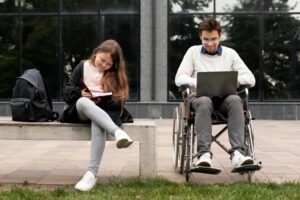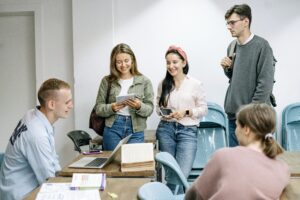Minimized Digital (Education) Discrimination
Materials
1. Introduction
1.1 Digital Education and Inclusivity
Since the 2000s, inclusion in digital education has received increased attention, particularly as technology has advanced. As digital education grows, inclusion remains a key priority. Digital platforms and methods that discriminate, whether purposefully or unintentionally, can worsen digital education discrimination. Therefore, one of the main goals in digital education is to ensure that all students, regardless of background or ability, have equal educational opportunities.
User-centered digital technologies provide innovative educational solutions, helping teachers in reducing administrative tasks and adapting to novel technologies such as generative artificial intelligence (AI). These technologies bring both advantages and disadvantages to the educational environment, including challenges with evaluation and authorship. Generative AI tools, in particular, are opening up new channels for learning, helping students improve their learning rate and self-efficacy (European Union, 2023).
Digital equity requires that all individuals have the digital capability (access and skills) to fully participate in society. Digital equity in education also refers to the distribution and use of tools in a way that does not discriminate against or limit the learning potential of specific groups. Using digital technology for equitable education refers to the use of digital tools for fostering equity in education, such as offering more resources to students through digital technology to meet their requirements (Gottschalk & Weise, 2023).
Equity in education refers to (European Commission, 2023):
‘the extent to which learners can fully enjoy their right to education and training in terms of opportunities, access, treatment, and outcomes‘.
Educators and educational institutions play a vital part in preventing digital discrimination. One of the main challenges for educators and policymakers is finding a balance between being current with technological advancements and guaranteeing equity and inclusiveness in digital education. They can accomplish this by identifying potential biases in digital platforms and selecting inclusive solutions that address diverse student needs.
Policymakers and educators must work together to establish an educational environment in which technology enables, rather than discriminates. Regulations, such as the Slovak Education Act and the Anti-Discrimination Act, can emphasize the commitment to equitable educational access for all. (Nevická & Mesarčík, 2022).
1.2 Purpose of this learning unit
The aim of this learning unit is to address the issues of digital educational discrimination and how to combat them, with a special focus on inclusivity for students with disabilities.
The learning unit starts with a discussion of inclusiveness in the digital era, including the issues of digital discrimination. This is elaborated on in sections that analyze the implications of such discrimination on students with disabilities, as well as the roles of educators and institutions in promoting a more inclusive digital educational landscape.
2. Minimizing Digital (Education) Discrimination
2.1 Digital Discrimination in Education
The United Nations Educational, Scientific and Cultural Organisation (UNESCO) refers to discrimination as (European Commission, 2023):
‘any distinction, exclusion, limitation or preference which, being based on race, colour, sex, language, religion, political or other opinion, national or social origin, economic condition or birth, has the purpose or effect of nullifying or impairing equality of treatment in education’
Discrimination based on disability is defined as (European Commission, 2023):
‘any distinction, exclusion or restriction on the basis of disability which has the purpose or effect of impairing or nullifying the recognition, enjoyment or exercise, on an equal basis with others, of all human rights and fundamental freedoms in the political, economic, social, cultural, civil or any other field. It includes all forms of discrimination, including denial of reasonable accommodation.’
Digital discrimination in education refers to biases and inequalities caused using digital technologies. It also refers to the injustices that occur when students’ access to technology or digital information is influenced by their socioeconomic status, disability, race, or other characteristics. Digital discrimination has been significant in online education in universities during the COVID-19 pandemic, affecting the availability of technological devices, human resource training, student and parent literacy rates, and institutional training (Khairiah et al., 2023).
Research conducted under the Digital Education Action Plan (DEAP) 2021-2027 reveals major digital gaps in the European Union’s less developed regions. Up to 26% of households in these locations lack access to digital technology, and children’s digital education is strongly influenced by their parents’ socioeconomic and educational backgrounds. The DEAP aims to improve digital skills and smoothly integrate digital education, supporting equitable access and fair implementation across schools (Nevická & Mesarčík, 2022).
During the COVID-19 pandemic in South Africa, for example, the switch to online learning resulted in discriminatory challenges regarding the legal right to education, especially affecting learners with disabilities, those from families with low incomes, and rural areas. By the end of 2020, South Africa has lost around 60% of its annual school days. Furthermore, just 5% of schools have had 90% of their students with computers and access to the internet at home (Mihigo, 2023).
Figure 1. What Is the Average Settlement for Disability Discrimination in Schools?
Figure 2. Digital Discrimination in Learning
Figure 3: Disability Discrimination in Schools | Ableism in Education
2.2 Strategies and Policies that Address Digital Discrimination
Member states that have ratified the 2006 United Nations Convention on the Rights of Persons with Disabilities (UNCRPD) acknowledge that education is a fundamental human right for all learners and the primary means by which they can realize other human rights, lift themselves out of poverty, and fully participate in their communities. Article 24 of the UNCRPD convention attempts to ensure that
‘Persons with disabilities can access inclusive, quality, and free primary and secondary education on an equal basis with others in the communities in which they live.’ (United Nations, 2016)
UNESCO promotes human rights-based approach to education and advocates for an inclusive dimension to the right to education, particularly through the implementation of the 1960 UNESCO Convention and Recommendation against Discrimination in Education (CADE), which establishes an international legal framework for the protection of the right to education and prohibits all forms of discrimination, including distinction, exclusion, limitation, or preference. (UNESCO, 2019).
UNESCO’s campaign against discrimination in education emphasizes the importance of ratifying the CADE, which seeks to preserve the right to learn by addressing new global requirements such as digital inclusion and learner data protection. The campaign highlights the role of legislation in establishing a more inclusive educational environment, proposing that recognizing and adhering to international norms can help prevent discrimination (UNESCO, 2020).
The EU has several legal, policy, and financial mechanisms established to address discrimination, particularly in the education sector. The current main EU strategy that tackles discrimination based on disability is the EU strategy for the Rights of Persons with Disabilities 2021-2030 (EUSRPWD). The EUSRPWD strategy also seeks to promote inclusive and accessible mainstream education, as well as upskilling and reskilling of people with disabilities, through various EU initiatives such as (European Commission, 2023)
- European Skills Agenda (https://ec.europa.eu/social/main.jsp?catId=1223&langId=en),
- Digital Education Action Plan (https://education.ec.europa.eu/focus-topics/digital-education/action-plan).
As a core value of the EU, the concept of equality refers to a
‘shared concern for human dignity; the participation by all in economic, social and cultural life; a voice for all groups in decisions that impact on them; and a celebration of diversity.’
European equal treatment legislation was created to reflect this core value by ensuring the basic principle of equal treatment and supporting and protecting people who face discrimination (European Commission, 2023).
The European Agency for Special Needs and Inclusive Education (EASNIE) (European Agency for Special Needs and Inclusive Education, 2024) is an independent organization that serves as a collaboration platform for member countries’ education ministries, with the goal of assisting member countries in improving inclusive education policy and practice for all learners.
2.3 The Impact of Digital Discrimination on Students with Disabilities
Digital discrimination against students with disabilities is a multidimensional problem that includes insufficient resources, ineffective school policies, inaccessible digital platforms, and negative peer attitudes. While there is a push for inclusivity and efforts to address digital discrimination against students with disabilities, challenges persist.
Students with disabilities face different challenges in digital learning environments, such as:
- Digital platforms do not meet the needs of students with cognitive disabilities (e.g. autism spectrum disorder).
- Students with emotional and behavioral disorders (e.g. anxiety) may struggle to engage and concentrate when using digital education systems that lack help for adjusting to changing emotions and intentions.
- Educational technologies sometimes do not accommodate to sensory processing issues, necessitating the use of alternative digital material forms.
- Some digital platforms might not be suited to the needs of those with intellectual disabilities, who may require simpler content and additional teaching time.
- Physical barriers, such as various motor impairments, might make digital resources inaccessible because they rely on traditional input methods like a mouse or keyboard.
- Participating in digital chats or using voice-based interfaces is more difficult for people with speech and language impairments.
- Visual and hearing disabilities, such as low vision, color blindness, and deafness, confront challenges because many digital education tools do not always include screen readers, high-contrast settings, transcripts, or sign language interpretation.
- etc.
To summarize, students with disabilities confront numerous challenges in online learning. They require digital tools that are simple to use and can assist with a variety of needs. We should all work together to improve online education for everyone, regardless of skill level.
2.4 Bridging the Digital Gap: Technological and Pedagogical Innovations for Inclusive Education
E-learning technology and applications can reduce discrimination in digital education by ensuring equal access and personalized learning experiences.
Learning Management System (LMS) like Moodle can serve as a central hub for varied students to access educational content. Moodle HQ, its community, and the Partner Network highlight that for online education to be fair and of high quality, it must adapt to a wide range of needs while following to Universal Design for Learning principles. This method requires that both educational systems and information be accessible and useful by everyone, regardless of ability. Some tips on how to make LMS content accessible can be found here (Verdauger, 2021). To learn more about how to develop accessible online courses on Moodle, please visit:
- Júlia Verdaguer, Tips to make your LMS content accessible – https://moodle.com/news/tips-to-make-your-lms-content-accessible/.
- Moodle Accessibility – https://docs.moodle.org/403/en/Accessibility.
- Accessibility Toolkit – A tool for improving the quality of online education by finding, fixing, and futureproofing content accessibility within Moodle – https://www.brickfield.ie/brickfield-accessibility-toolkit/.
- Inclusive curriculum briefing: using Moodle – https://teachinghub.bath.ac.uk/wp-content/uploads/2023/09/Inclusive-curriculum-briefing.pdf
Virtual Reality (VR) and Augmented Reality (AR) are innovative tools that have the potential to transform the way we educate and engage students. By incorporating VR and AR technologies into education, we can develop engaging learning experiences that improve student engagement, comprehension, and overall academic outcomes (Singh, 2023). Some of the most prevalent benefits of employing VR and AR tools for students with disabilities identified in existing studies include increased student engagement, interaction, and curiosity generation. (Quintero, Baldiris, Rubira, Cerón, & Velez, 2019)
VR and AR simulations can provide equal possibilities for learners with disabilities or others who do not have access to real-world resources to interact with educational information. Furthermore, these tools allow students to engage with other cultures, historical events, and surroundings that might otherwise be inaccessible, encouraging empathy and understanding (Singh, 2023).
VR demonstrates the ability to deliver a seamless education for anyone wanting to learn a second language. VR and AR can translate and transcribe educators’ lessons, allowing students to understand and learn more quickly. Students frequently hesitate to speak or ask questions during online learning because they are concerned about mispronouncing words or sentences. VR and AR allow for easier and more flexible interactions (Spilka, 2023).
Cloud-based solutions, like Google Workspace, enable students with physical disabilities to engage in collaborative work remotely. Google for Education products were designed with accessibility in mind, enabling every student to learn, be inspired, and reach their full potential. The Google Workspace features technologies such as:
- Google Classroom enhances communication and collaboration between students and teachers, promoting inclusive learning settings.
- Google Meet is a video-based platform that promotes inclusive education and supports distance learning.
- Use Google Slides to create, edit, and collaborate on presentations with screen readers, braille displays, and live captioning.
More information regarding the accessibility features available across Google Workspace for Education can be found at https://edu.google.com/why-google/accessibility/google-workspace-for-education-accessibility/. Examples of successful use cases for Google Workspace:
- In Harrison Township’s inclusive classrooms, all students benefit from accessibility tools –https://edu.google.com/why-google/customer-stories/harrison-township/.
- Ontario’s Upper Grand District chooses Chromebooks to help students with disabilities build confidence in learning – https://edu.google.com/why-google/customer-stories/upper-grand-district/
- Creating an “accessibility for all” culture in classrooms through technology – https://edu.google.com/why-google/customer-stories/accessibility/.
Modern teaching methods that are inclusive and adaptive and that can also help decrease digital education discrimination:
- Universal Design for Learning (UDL) focuses on creating accessible course content for all students, including those with disabilities. Accessibility is a key component of UDL, which is an intentional and systematic approach for building a learning environment that accommodates diversity and difference between and among students (https://moodle.com/news/tips-to-make-your-lms-content-accessible/).
- Differentiated Instruction allows educators to adapt teaching environments to suit different learning needs, including the use of visual aids and interactive tasks. Differentiated instruction is considered as one of the essential means to effective education for all students including those with disabilities (Strogilos, 2018). Differentiation refers to a varied preparation and design of inclusive teaching practice in a reactive way by reacting to the needs of students (while e.g. UDL is a proactive approach, which ensures access for all students regardless of their needs) (Lindner & Schwab, 2020).
- Problem-based learning (PBL) methods have positive effects on academic achievement, student engagement and attitudes, class-room environments, self-efficacy, and social skills for both students with learning disabilities and general education students in the science classroom (Meek, 2020).
- Project Based Learning (PBL) is a dynamic teaching method that emphasizes inquiry and reflection, promoting student independence, growth, and collaboration while preparing them for real-world challenges. It encourages integrating identity exploration into education, recognizing its importance in fostering diversity, equity, inclusion, and understanding the impact of personal and social identities on students’ engagement with PBL tasks and community building (Syvertsen, 2023). The benefits of using PBL in classroom are for example (1) PBL is customizable to fit every student’s individual learning needs, (2) PBL helps build social and presentation skills, and (3) PBL bridges the gap between the classroom and the real world (Kumiega, 2024). Read more about the benefits of PBL for special education and inclusion here (Uliasz, 2016; Webster, 2019) and how to use PBL here (Kilby, 2018).
- The Flipped Classroom (FP) paradigm can engage students in real-world situations while allowing them to learn at their own pace, which is especially beneficial for underprivileged pupils. The FP approach reverses traditional teaching approaches, offering lectures outside of class and devoting class time to problem solving, with the teacher serving as a learning coach and facilitator. This paradigm enables more hands-on, student-driven learning during class time. A flipped classroom offers improved student motivation, customized instruction, self-paced lessons and mastery learning, increased collaboration, and rapid feedback for formative assessment (Altemueller & Lindquist, 2017). A practical guide for teachers and trainers to use FP can be found here (European Commission, 2018).
- Gamification is a learning strategy that employs game-based elements, such as point scoring, implementation of goals/targets, and competition among students. (Stuart-Chaffoo, 2022). Gamification in education improves student engagement and comprehension and is also a great approach to apply UDL’s three key ideas: (1) providing students with diverse ways to become engaged in learning, (2) different ways to learn, and (3) different ways to comprehend information. This makes learning more inclusive and beneficial to all students (Quintero et al., 2022). Gamification provides inclusive and individualized learning opportunities for individuals with varied disabilities. Methodologies and approaches to implement gamification that can be identified in the existing literature include game elements, user-centered design techniques, and emerging technologies such as virtual reality, artificial intelligence, and educational robotics (Jadán-Guerrero, Avilés-Castillo, Buele, & Palacios-Navarro, 2023).
Above presented pedagogical approaches value diversity in learning processes and work towards reducing discrimination in digital education. By implementing a range of strategies, educators can create more inclusive digital learning environments that celebrate the diversity of student populations.
3. Conclusion
This learning unit explored the issue of digital discrimination and how it affects students. While digital technologies offer several benefits, they must be carefully designed and maintained to ensure that everyone has equal learning opportunities. The unit has underlined the need for collaboration among educators, technology providers, and policymakers to make digital learning more equitable for all.
References
Altemueller, L., & Lindquist, C. (2017). Flipped classroom instruction for inclusive learning. British Journal of Special Education, 44(3), 341–358. https://doi.org/10.1111/1467-8578.12177
European Agency for Special Needs and Inclusive Education. (2024). European Agency for Special Needs and Inclusive Education. Retrieved from https://www.european-agency.org/
European Commission. (2018). Flipped Classroom in Practice. Retrieved from https://ec.europa.eu/programmes/erasmus-plus/project-result-content/17061004-3280-44bc-81ca-463b3f329b5d/Flipped Classrom in Practice EN.pdf
European Commission. (2023). Tackling different forms of discrimination in and through education and training. (V. Donlevy, B. van Driel, S. Komers, & M. R. Melstveit, Eds.). https://doi.org/10.2766/798464
European Union, E. C. (2023). Council recommendation on the key enabling factors for successful digital education and training.
Gottschalk, F., & Weise, C. (2023). Digital equity and inclusion in education: An overview of practice and policy in OECD countries. Organisation for Economic Co-Operation and Development, (299), 1–73. Retrieved from https://dx.doi.org/10.1787/7cb15030-en
Jadán-Guerrero, J., Avilés-Castillo, F., Buele, J., & Palacios-Navarro, G. (2023). Gamification in Inclusive Education for Children with Disabilities: Global Trends and Approaches – A Bibliometric Review (pp. 461–477). https://doi.org/10.1007/978-3-031-37105-9_31
Khairiah, K., Mubaraq, Z., Mareta, M., Musa, D. T., Naimah, N., & Sulistyorini. (2023). Discrimination in Online Learning During the COVID-19 Pandemic in Indonesian Higher Education. Journal of Law and Sustainable Development, 11(3), e710. https://doi.org/10.55908/sdgs.v11i3.710
Kilby, A. M. (2018). Using Project-Based Learning in Special Education Classrooms.
Kumiega, J. (2024). 3 Benefits of Using PBL in a Special Education Classroom. Retrieved from https://blog.definedlearning.com/blog/3-benefits-using-pbl-special-education-classroom
Lindner, K.-T., & Schwab, S. (2020). Differentiation and individualisation in inclusive education: a systematic review and narrative synthesis. International Journal of Inclusive Education, 1–21. https://doi.org/10.1080/13603116.2020.1813450
Meek, H. (2020). Problem-based Learning for Students with Learning Disabilities in Science Classrooms. Learning to Teach. Retrieved from openjournals.utoledo.edu
Mihigo, F. (2023). Digital technology, the right to education and the issue of inclusivity in South Africa: lessons from COVID-19. Retrieved from https://gchumanrights.org/preparedness-children/article-detail/digital-technology-the-right-to-education-and-the-issue-of-inclusivity-in-south-africa-lessons-from-covid-19-5046.html
Nevická, D., & Mesarčík, M. (2022). Why are you offline? The issue of digital consent and discrimination of Roma communities during pandemic in Slovakia. International Journal of Discrimination and the Law, 22(2), 172–191. https://doi.org/10.1177/13582291221096615
Quintero, J., Baldiris, S., Ceron, J., Garzon, J., Burgos, D., & Velez, G. (2022). Gamification as Support for Educational Inclusion: The Case of AR-mBot. In 2022 International Conference on Advanced Learning Technologies (ICALT) (pp. 269–273). IEEE. https://doi.org/10.1109/ICALT55010.2022.00088
Quintero, J., Baldiris, S., Rubira, R., Cerón, J., & Velez, G. (2019). Augmented Reality in Educational Inclusion. A Systematic Review on the Last Decade. Frontiers in Psychology, 10. https://doi.org/10.3389/fpsyg.2019.01835
Singh, R. (2023). Enhancing Education with Virtual Reality (VR) and Augmented Reality (AR) in the Digital Age. Retrieved from https://www.linkedin.com/pulse/enhancing-education-virtual-reality-vr-augmented-ar-digital-singh/
Spilka, D. (2023). How VR And AR Are Revolutionizing eLearning For Learners Of All Ages. Retrieved from https://elearningindustry.com/how-vr-and-ar-are-revolutionizing-elearning-for-learners-of-all-ages
Strogilos, V. (2018). The value of differentiated instruction in the inclusion of students with special needs/ disabilities in mainstream schools. SHS Web of Conferences, 42, 00003. https://doi.org/10.1051/shsconf/20184200003
Stuart-Chaffoo, E. (2022). Why Gamification Helps Children with Special Educational Needs. Retrieved from https://www.nightzookeeper.com/blog/articles/why-gamification-helps-children-with-special-educational-needs
Syvertsen, P. (2023). Using PBL to Support an Inclusive Classroom Community. Retrieved from https://blog.definedlearning.com/pbl-supports-inclusive-classroom-community
Uliasz, K. (2016). Inclusive Special Education via PBL. Retrieved from https://www.pblworks.org/blog/inclusive-special-education-pbl
UNESCO. (2019). The right to education for persons with disabilities. Retrieved from https://unesdoc.unesco.org/in/documentViewer.xhtml?v=2.1.196&id=p::usmarcdef_0000371249&file=/in/rest/annotationSVC/DownloadWatermarkedAttachment/attach_import_d71d00d2-5c17-48d2-ada0-66e0a4cdb2ec%3F_%3D371249eng.pdf&locale=en&multi=true&ark=/ark:/48223/p
UNESCO. (2020). Ending Discrimination in Education: a key instrument to protect the right to education. Retrieved from https://www.unesco.org/en/articles/ending-discrimination-education-key-instrument-protect-right-education
United Nations. (2016). Convention On The Rights Of Persons With Disabilities (CRPD). Retrieved from https://social.desa.un.org/issues/disability/crpd/convention-on-the-rights-of-persons-with-disabilities-crpd
Verdauger, J. (2021). Tips to make your LMS content accessible. Retrieved from https://moodle.com/news/tips-to-make-your-lms-content-accessible/
Webster, J. (2019). Project Based Learning for Special Education and Inclusion. Retrieved from https://www.thoughtco.com/project-based-learning-for-special-education-3111012
1. Leadership/ School’s perspective
Inclusive Digital Strategy and Policy for Empowering Inclusive Digital Education
…..
15 min
Understand and describe negative aspects of digital discrimination in digital education. Discuss measures that eliminate digital discrimination in the field of digital education.
Digital discrimination in education; equality; equity in digital education; discrimination based on disability








Funded by the European Union. Views and opinions expressed are however those of the author(s) only and do not necessarily reflect those of the European Union or the European Education and Culture Executive Agency (EACEA). Neither the European Union nor EACEA can be held responsible for them (2022- 1 -SI01 -KA220-HED-000088368).






